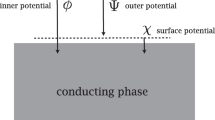Abstract
The representation of the shape of a biconcave erythrocyte by a set of three parametric equations was achieved by using the expressions that transform the curvilinear coordinates from the disc-cyclide coordinate system [denoted J2R; Moon and Spencer (1988), Field Theory Handbook, Springer-Verlag, Berlin] to Cartesian coordinates. The equations are products of elliptic functions, so the challenge was to relate the three major ’shape-defining’ measurements of the human erythrocyte in Cartesian coordinates to three parameters in the new curvilinear coordinates, to give a realistic representation of the shape of the membrane-surface. The relationships between the coefficients of the Cartesian degree-4 surface that describes the discocyte and the coordinate transformation equations were derived with the aid of Mathematica; and the membrane-surface of the cell was drawn using the ParametricPlot3D function in this ‘package’. By having the erythrocyte shape expressed in its new form it is readily amenable to further transformations that might be used to model those changes in shape that are seen when the cells are immersed in media of various osmolalities, or when they change metabolic ’states’. On the other hand, the relationship between the coefficients of the Cartesian expression for the disc-cyclide surface is relevant to image analysis of erythrocytes, as determined by physical methods that rely on Cartesian imaging ’slices’. These methods include confocal microscopy and various nuclear magnetic resonance microimaging procedures.
Similar content being viewed by others
References
Adams, K. H. (1973). A theory for the shape of the red blood cell. Biophys. J. 13, 1049–1053.
Beck, J. S. (1978). Relations between membrane monolayers in some red cell shape transformations. J. Theor. Biol. 75, 487–501.
Blachman N. R. and M. J. Mossinghoff (1994). Maple V Quick Reference. Pacific Grove, CA: Brooks/Cole.
Bowman, F. (1961). Introduction to Elliptic Functions. New York, NY: Dover.
Dixon, A. C. (1894). The Elementary Properties of the Elliptic Functions with Examples London: Macmillan.
Evans, E., and Y.-C. Fung (1972). Improved measurements of the erythrocyte geometry. Microvasc. Res. 4, 335–342.
Funaki, H. (1955). Contributions on the shapes of red blood corpuscles. Jpn. J. Physiol. 5, 81–92.
Glaser, R. (1979). The shape of red blood cells as a function of membrane potential and temperature. J. Membr. Biol. 51, 217–228.
Gulliver, G. (1875). Observations on the sizes and shapes of the red corpuscles of the blood of vertebrates, with drawings of them to a uniform scale, and extended revised tables of measurements. Proc. Zool. Soc. Lond. June 15, 474–495.
Hoffman, J. (1987). On the mechanism and measurement of shape transformations of constant volume of human red blood cells. Blood Cells 12, 565–586.
Kuchel, P. W., B. T. Bulliman and E. D. Fackerell (1987). Bi-cyclide and flat-ring cyclide coordinate surfaces: correction of two expressions. Math. Comput. 49, 607–613.
Kuchel, P. W. and B. T. Bulliman (1988). Expressions for surfaces in disk-cyclide coordinates: derivations using symbolic computation. J. Franklin. Inst. 325, 505–508.
Kuchel, P. W., and B. T. Bulliman (1989). Perturbation of homogeneous magnetic fields by isolated single and confocal spheroids. Implications for NMR spectroscopy of cells. NMR Biomed. 2, 151–160.
Kuchel, P. W., A. Coy, and P. Stilbs (1997). NMR ‘diffusion-diffraction’ of water revealing alignment of erythrocytes in a magnetic field and their dimensions and membrane transport characteristics. Magn Reson. Med. 37, 637–643.
Lennon, A J., N. Scott, B. E. Chapman and P. W. Kuchel (1995). Haemoglobin affinity for 2,3-bisphosphoglycerate in solutions and intact erythrocytes: studies using pulsed field gradient NMR and Monte Carlo simulations. Biophys. J. 67, 2096–2109.
Moon, P. and D. E. Spencer (1951). Cylindrical and rotational coordinate systems. J. Franklin Inst. 252, 327–344.
Moon, P. and D. E. Spencer (1953). Some coordinate systems associated with elliptic functions. J. Franklin Inst. 255, 531–543.
Moon, P. and D. E. Spencer (1961). Field Theory for Engineers. Princeton, NJ: Van-Nostrand.
Moon, P. and D. E. Spencer (1988). Field Theory Handbook. Including Coordinate Systems Differential Equations and Their Solutions. Berlin: Springer-Verlag.
Torres, A. M., R. J. Michniewicz, B. E. Chapman, G. A. R. Young and P. W. Kuchel (1998). Characterisation of erythrocyte shapes and sizes by NMR diffusion-diffraction of water: correlation with electron micrographs. Magn. Reson. Imag. (in press).
Vayo, H. W. (1983). Some red blood cell geometry. Can. J. Physiol. Pharmacol. 61, 646–649.
Wolfram S. (1996). Mathematica: a System for Doing Mathematics by Computer, Version 3. Redwood City, CA: Addison-Wesley.
Author information
Authors and Affiliations
Rights and permissions
About this article
Cite this article
Kuchel, P.W., Fackerell, E.D. Parametric-equation representation of biconcave erythrocytes. Bull. Math. Biol. 61, 209–220 (1999). https://doi.org/10.1006/bulm.1998.0064
Received:
Accepted:
Issue Date:
DOI: https://doi.org/10.1006/bulm.1998.0064




